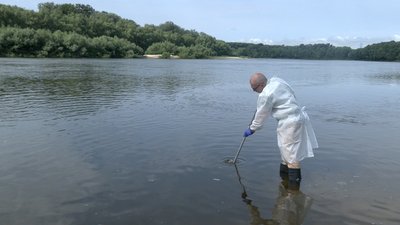Russian pollution causes massive fish die-off in Ukraine’s Seym and Desna rivers
Russian pollution has caused nearly 30 tons of fish to die in Ukraine's Seym and Desna rivers. Authorities are monitoring the contamination, expected to reach Kyiv by 14-16 September.


Russian pollution has caused a significant environmental crisis in Ukraine’s Seym and Desna rivers, resulting in a massive fish die-off totaling nearly 30 tons, according to Liga, referring to a Ministry of Environmental Protection and Natural Resources of Ukraine’s report.
According to Ukraine’s Prime Minister Denys Shmyhal, a discharge of waste from a sugar factory in Tyotkino in Russia’s Kursk Oblast caused organic pollution in the Seym River, leading to the mass fish die-off downstream in Ukraine.
As of 10 September, the contamination has moved approximately 191 km downstream from the confluence of the Seym and Desna rivers, as per the Environment Ministry. It says the pollution is progressing unevenly, with the most severe impacts observed near the village of Shestovytsia. In this area, authorities have noted water discoloration, a distinct odor, accumulation of small fish near the shore, and isolated instances of fish mortality. The situation appears to be improving near Chernihiv, with only sporadic fish deaths reported.
Dissolved oxygen levels, crucial for aquatic life, have dropped significantly in some areas. Near the village of Boromyky, levels have plummeted to 0.26 mgO₂/dm³, far below the normal threshold of 4 mgO₂/dm³. However, between the villages of Velyke Ustia and Kladkivka, oxygen levels have normalized to 4.7-7.85 mgO₂/dm³.
The Ministry also reports elevated levels of manganese and iron in certain areas. Manganese concentrations exceed normal levels by 3.8 to 8.4 times in Pekariv, Boromyky, and Chernihiv, while iron levels are 2.3 times higher than normal in Boromyky and Chernihiv. Environmental authorities note that some increase in manganese levels is typical for this time of year due to natural factors. However, the current levels significantly exceed historical norms for the season.
The Ukrainian Hydrometeorological Center forecasts that the contamination will reach the borders of Kyiv Oblast between 14-16 September. This progression has raised concerns about potential impacts on water sources for the capital and surrounding areas.
Related:
- Ukrainian scientists race to document soil fungi amid ongoing war
- Russia destroys over 60,000 hectares of Ukrainian forests worth over $ 360 mn – investigation
- Russia constructs fourth pontoon bridge across Seym River in Kursk Oblast, satellite imagery shows
- Water level in Dnipro dropped by 1.5 meters due to damage by Russians, fish dying en masse (2023)
- Russia destroys Europe’s largest poultry farm, 4.4mn chickens dead (2022)



